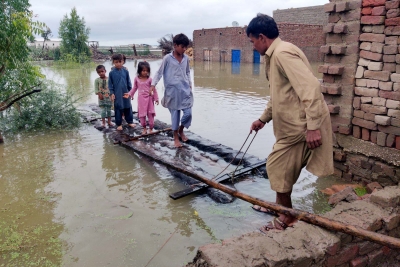Climate hazards convert infrastructure failures into humanitarian catastrophes in Pakistan: Report
By IANS | Updated: November 26, 2025 21:05 IST2025-11-26T21:00:25+5:302025-11-26T21:05:19+5:30
Sofia, Nov 26 Pakistan is experiencing compound hazards, heat stress, glacial instability and intense rainfall that together convert ...

Climate hazards convert infrastructure failures into humanitarian catastrophes in Pakistan: Report
Sofia, Nov 26 Pakistan is experiencing compound hazards, heat stress, glacial instability and intense rainfall that together convert infrastructure failures into humanitarian catastrophes, a report cited on Wednesday.
The floods in Pakistan have impacted around 33 million people, left millions homeless, damaging farmland and killing hundreds this year, a report in Bulgaria-based Modern Diplomacy highlighted.
These floods were compounded by mountain hazards like Glacial-Lake Outburst Floods (GLOFs) during summer in Pakistan-occupied Gilgit-Baltistan which destroyed several homes in various villages and briefly created large, newly emergent lakes that cut off roads and tourism circuits in fragile mountain economies.
The loss of homes, guesthouses and economic base of people of mountainous regions showcases how poorly planned transport and tourism infrastructure can increase the harm caused by climate-driven glacier changes.
Pakistan also faced heatwaves in 2025, with many urban centres and rural plains experiencing temperatures far more than seasonal norms. The month of April was the second-hottest in 65 years with national mean temperature about 3.37 degree centigrade above historical standard.
"Heat stress has direct impacts on labour productivity, public health and the viability of energy systems, spiking demand at exactly the moment supply is least secure. The return of La Nina this winter poses another test of Pakistan’s resilience, as shifting temperature and rainfall patterns will once again reveal how exposed communities, ecosystems, and infrastructure remain to a changing climate. In short, Pakistan is experiencing compound hazards, heat stress, glacial instability, and unusually intense rainfall that together convert ordinary infrastructure failures into humanitarian catastrophes," Arooj Saghir wrote in Modern Diplomacy.
"Why do these predictable collisions between people, nature and climate still happen? Why are the same infrastructure fail-points recurring? What good is growth if it washes away each year? Why villages again suffer loss, why roads wash away, why power systems falter and why communities bear the worst harm? The patterns are familiar: inadequate spatial planning that ignores biodiversity and hydrology, weak enforcement of EIAs and social safeguards, faulty compensation and resettlement processes that leave families poorer and more exposed, and infrastructure designed to historical standards rather than future climates," she added.
As rainfall intensifies, drainage and bridges collapse, hydraulic structures are undersized and embankments along rivers like the Chenab, Sutlej and Ravi are breached as they were not upgraded to accommodate altered flow regimes, upstream glacial melt, or increased rainfall.
"Since most of the infrastructure is still built with the old climate baseline in mind, monsoon design storms, flood embankments, drainage systems calibrated for decades-old rainfall intensities. As rainfall intensifies, drainage and bridges collapse; hydraulic structures (culverts, flood bypasses) are undersized. Embankments along rivers like the Chenab, Ravi and Sutlej are overtopped or breached because they were not upgraded to accommodate altered flow regimes, upstream glacial melt, or enhanced rainfall due to La Nina cycles.
"Recent floods showed how urban drainage systems and river embankments, often built or altered without integrated watershed assessments, were overwhelmed. Releases from upstream reservoirs and poorly coordinated transboundary water management also amplified downstream impacts. Building dams and roads without resilience is no longer progress; it is policy myopia. Where accountability is thin and safeguards are procedural rather than substantive, projects proceed on convenience rather than resilience, and the poorest pay the price," the report mentioned.
Disclaimer: This post has been auto-published from an agency feed without any modifications to the text and has not been reviewed by an editor
Open in app